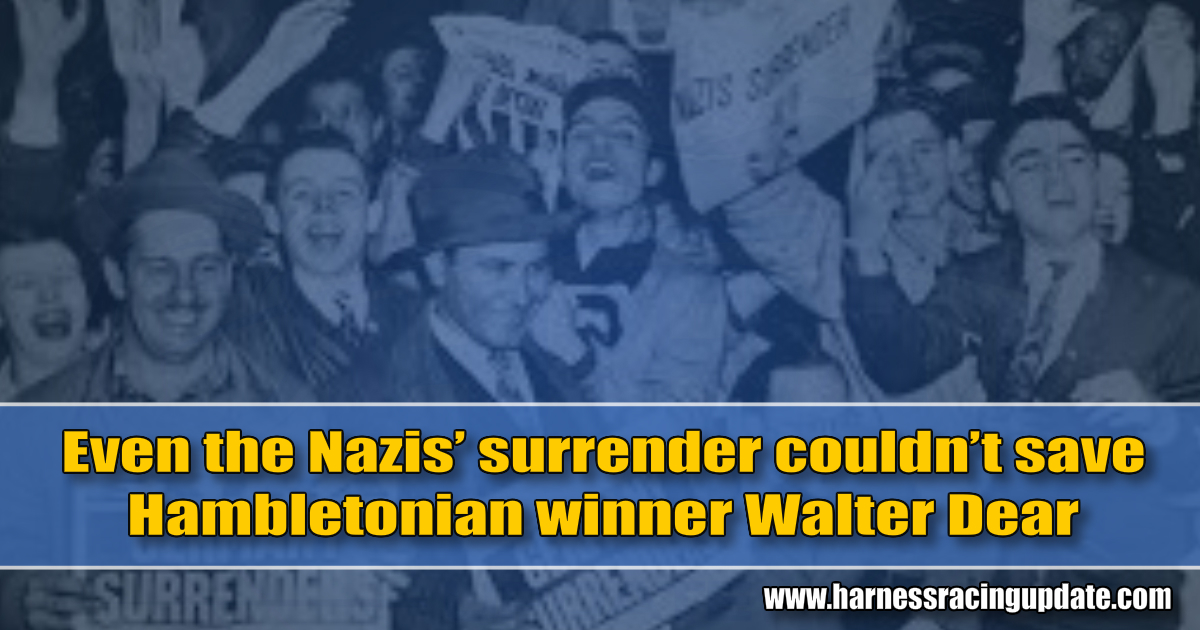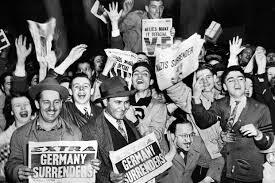

Even the Nazis’ surrender couldn’t save Hambletonian winner Walter Dear
Today is the 75th anniversary of VE Day marking the Nazis’ unconditional surrender, a celebration followed by the glorious return of trotting to Europe after some dark days for the standardbred breed that included the tragic death of 1929 Hambletonian and 1934 Prix d’Amerique winner Walter Dear.
by Ulf Lindstrom
For those born in and around 1920 – later known as The Great Generation – May 8, 1945 was a momentous day still celebrated 75 years on as VE Day (Victory in Europe Day — marking the formal acceptance by the Allies of Nazi Germany’s unconditional surrender of its armed forces).
May 9, 1945 was less of a cause for celebration, but momentous in its own right as life started to return to normal and people went back to work. But five years of war and, before that, 10 years of economic hardship and dictatorship in most of Europe, had robbed many of their youth.
In the ruins of Europe, life returned with moments of joy to soothe the pain, allow lapses of forgetfulness and to share comfort. A decade before television made its breakthrough, people sought inspiration at political rallies, guidance at places of worship and found company for pleasure at the cinemas, dance halls and sports events.
Trotting in Europe had its window of opportunity. With prospects of both ice cream and hot dogs, the post-World War II years brought the kids to the racetracks, the baby boomers who today still make up the bulk of the spectators at the races.
Oslo’s Bjerke Racetrack premiered on July 1, 1945. It was a Sunday, with 17,000 in attendance. For Berlin it was different. Karlshorst Racetrack offered soup. On that same day, July 1, in the Soviet occupied sector of the city, some of the 20,000 to 50,000 who came to the first race day after the surrender of the Third Reich on May 7 were attracted by a mug of free vegetable soup.
The Soviet commandant Berzarin had approved of the return of racing under the condition that no ’fascist’ trainers, drivers, and officials were allowed to the grounds. Bomb craters were filled, debris cleared. Horses were gathered from the American sector, too, an hour from Mariendorf under the supervision of the Red Army veterinarians.
Also liberated by Soviet troops, Vienna held its first race day at Krieau on Nov. 11. Thirteen thousand came. Missing to lead the post parade was the most mythical Austrian stallion of all time, Heinrich (b. 1927, Ernest Axtell–Heimchen–Lord Revelstoke). He won the German Derby of 1931 by 100 meters (the world’s oldest race for 4-year-olds). With only two offspring registered, he was stabled at Baden. When he rose against the soldiers that came to get him for the post parade, he was immediately shot.
Berlin and Vienna were the principal European turfs for the standardbred, since Paris was and is for the Franco-American. Upon liberation by the Red Army, the stocks of trotters were severely taxed. Estimates for Berlin alone say 3,000 head of trotters were taken to feed the troops, freed prisoners of war and other needy. The most prominent was Walter Dear (The Laurel Hall–Blitzie), the winner of the 1929 Hambletonian and 1934 Prix d’Amerique and the only horse in history to win both.
He had been brought to Germany by Bruno Cassirer (instead of Volomite, legend says). Cassirer, a Jewish refugee, passed away in London in 1938.
Walter Dear, in training with Charlie Mills at his farm outside Berlin, was an asset at stud. His son Probst (out of Probable), finished second in the 1939 Prix d’Amerique andSturdy (born1931, Guy Axworthy—The Great Miss Morris) are believed to have been abducted in the same sweep by the Red Army.
At that time, the USSR was still an important nation in the trotting industry with equine expertise at the state studs. Otherwise, the performances by the Soviet-bred horses at the legendary Russian Gala at Solvalla, Sweden in 1954 (believed to still hold the record for attendance) would not have impressed with competitive entries.
That, for reflection, opens a naive thought: what about Soviet cavalry in the final battle for Berlin? Officers with a minimum of knowledge of horse breeding ought to have interfered to separate nags from the blue blooded head, to have them shipped home to state studs with names changed and promising prospects to expect. At about the same time, U.S. General Patton had okayed a successful raid by American cavalry (motorized) into Soviet-occupied Czechoslovakia to rescue Lippizaners confiscated by the Third Reich back to the Spanish School in Vienna. The comparison is awkward, however. A similar initiative by a Red Army general would have questioned the received wisdom of communist genetics, the Lysenko doctrine on genes as subordinate to environment. Lysenko had the backing of Generalissimo Josef Stalin.
Walter Dear had 193 offspring, born between 1932 and 1945, with 32 stakes winners, 27 as damsire. Probst had 41 offspring, born 1942-1946, three stakes winners in crops with few stakes and disrupted racing schedules. Probst’s most celebrated offspring was the mare Nobleness (b. 1943 out of Noble Lady). She birthed three full siblings by Permit, German Derby winners Gutenberg 1959, Hadu 1960 and Lord Pit 1964.
Data banks confirm that Walter Dear and three of his U.S.-born full brothers served at stud with success. (His half-brother Sam Williams founded the sire-line to Coktail Jet).
Ulf Lindstrom is professor emeritus of political science and a “desktop breeder,” located outside Stockholm, Sweden.


















